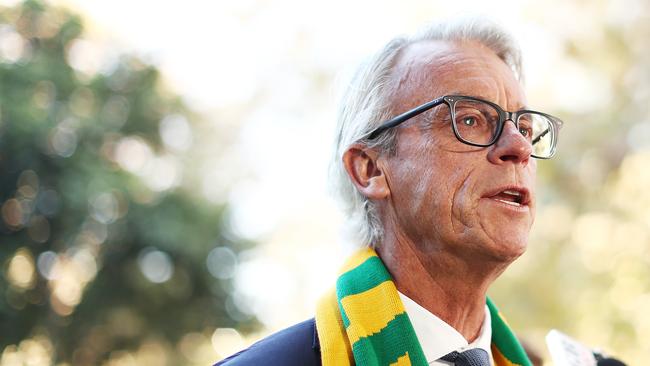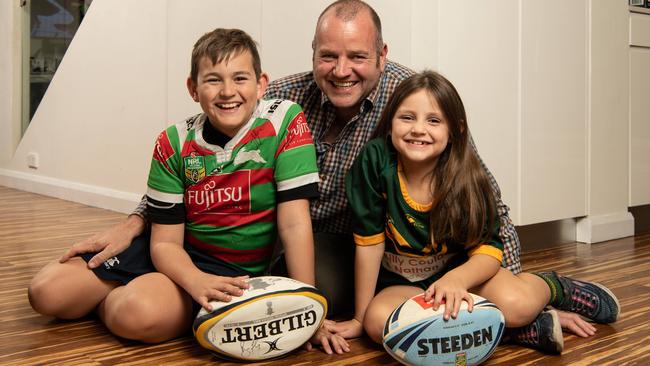Children’s sports clubs issued guidelines for transgender players
Sporting clubs have been asked to adopt a series of new gender guidelines which would allow transgender children to compete against any sex they identify as and pressure clubs to pay for sanitary bins in both male and female bathrooms.
NSW
Don't miss out on the headlines from NSW. Followed categories will be added to My News.
Sporting clubs have been asked to adopt a series of guidelines to allow transgender children to compete as the sex they identify as and have girl’s teams stock skirts in sizes to fit gender-diverse players.
The guidelines — produced by the Australian Human Rights Commission and Sports Australia — mean clubs would need to allow a biological boy to compete against girls as long as they are 12 years old or younger.

Clubs were also encouraged to create “a gender-neutral space” within changerooms and use “correct names and pronouns” in “conversations, databases, documents and correspondence”.
Female teams would need to stock “a tennis skirt in an appropriate size” to fit a “trans woman” playing on the team, if they adopted the new guidelines and clubs would have to pay for sanitary bins in both male and female bathrooms.
GUIDELINES TO SUPPORT TRANS CHILDREN
The guidelines were contained in a document released earlier this month which was signed by Coalition of Major Professional and Participation Sports chair David Gallop, Sex Discrimination Commissioner Kate Jenkins and Sports Australia chief executive Kate Palmer.
If adopted, the changes would impact the nine million athletes across 16,000 clubs Mr Gallop represents, including cricket, rugby, football, netball and tennis.
INCLUSION MOVE
Mr Gallop said in the report that the guidelines would boost the “inclusion of transgender and gender diverse people in sport”.
“The guidelines provide a significant opportunity for all of those involved in Australian sports — from grassroots participants and clubs to governing bodies — to reflect on how they can facilitate diversity and inclusion,” he said.
“COMPPS encourages all of its members to take active steps to welcome and encourage transgender and gender diverse people to participate in their sports.”
Ms Jenkins said the guidelines would address “unlawful discrimination” against transgender people in sport.

“The guidelines provide information on the operation of the (Sex Discrimination) Act, and practical guidance on how sporting organisations, their staff and volunteers can promote the inclusion of transgender and gender diverse people in line with human rights-based principles.
“I look forward to sporting organisations using these guidelines to ensure that their policies and practices comply with the Act, and are designed to maximise the inclusion of transgender and gender diverse people in their sport.”
Unpaid volunteers donating their time to a local sporting club such as soccer or cricket would have to adhere to the guidelines as well as paid coaches and staff.
IDENTITY ISSUES
Sporting organisations were also encouraged to rewrite official policies to say: “participation in sport should be based on a person’s affirmed gender identity and not the sex they were assigned at birth, to the fullest extent possible”.
“If applicable, (provide) confirmation that players will not be asked to undergo a medical examination for the purposes of gender verification.” This would allow athletes to self identify as either gender without a medical examination.

A series of “case studies” were included in the report to explain how the guidelines would work but the AHRC was unable to confirm if the examples were real or hypothetical.
“Xanthe is 10 years old, and was assigned as male at birth but identifies as a girl,” the document explains.
“Tournament organisers have contacted Xanthe’s club to explain that because her birth certificate indicates her gender as ‘male,’ she won’t be able to participate. When Xanthe’s club asks for an explanation the organisers explain that there is a concern that the competition won’t be ‘fair’ because Xanthe is ‘too strong’.”
The case study goes on to explain that the under the Sex Discrimination Act 1984 “Xanthe is able to participate in the tournament”.
ROOM FOR CHANGE
Clubs were asked to make bathrooms and changerooms more “inclusive” by “changing the signage on some of the facilities to unisex/gender neutral to provide an option for non-binary people” and “ensuring that all changerooms have sanitary bins”.
A spokeswoman for the AHRC said there were ways to minimise the cost of implementing the policies.
“Most of the suggestions in the guidelines inclusion checklist do not have a cost implication,” she said.
“For example, the guidelines suggest that facilities can be inclusively designed when sporting organisations move facilities, upgrade existing facilities, or build new facilities.”
Australian Catholic University senior research fellow Dr Kevin Donnelly said the issue of identifying as a different gender could create unfair advantages in sport.
“Men who self-identify are at an advantage and it is totally unfair for women in the world of sport,” he said, adding that the rise in gender theory being taught to children had increased the number of children identifying as transgender.
“They have been indoctrinated by the education they are getting,” he said.
A Sports Australia spokeswoman said “improving behaviours, attitudes and awareness can cost nothing”.
“We know there are some gender diverse participants who stay away from sport for fear of exclusion,” she said..
“These Guidelines can help sports with implementing or adapting their own inclusion policies and codes of conduct.
“It isn’t always practical or affordable to build specific facilities, but there could be cost-effective options to consider how those facilities are used. For example, a club could decide to assign some of their facilities as unisex. For things such as uniforms, it could be as simple as allowing participants to wear their preferred official uniform.”
A TRICKY PITCH TO PLAY ON
One junior cricket coach believes rewriting kids’ sport rules with a gender-inclusion emphasis could be a tricky wicket that may run the risk of singling out transgender children from their teammates.
Coach of the South Sydney Mt Carmel Junior Cricket Club James Cullen said he approved of children diagnosed as transgender not being discriminated against in sports but said there was a danger that the new guidelines could hamper their integration with peers.

“If there are too many hoops for transgender children to jump through it will put them off sport, so I agree with anything to make it easier for all children to play,” Mr Cullen said.
“All children should be given the opportunity to play whatever sport they like.
“My concern, however, is that the new guidelines designed to look after transgender children is asking clubs to treat them differently, and that’s worse.
“It’s putting them on a pedestal when they need to be made to feel as normal as possible and like their peers.”
He also raised the issue of overhauls in changerooms.
“Who is going to update these sporting clubs where facilities are very old?”
Originally published as Children’s sports clubs issued guidelines for transgender players


